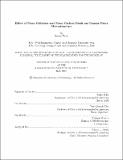Effect of nano Cellulose and nano carbon black on cement paste microstructure
Author(s)
Taha, Sama Tarek Sayed.
Download1193319916-MIT.pdf (8.912Mb)
Other Contributors
Massachusetts Institute of Technology. Department of Civil and Environmental Engineering.
Advisor
Franz-Joseph Ulm and Thibaut Divoux.
Terms of use
Metadata
Show full item recordAbstract
Over the last few years, nanotechnology has emerged as a breakthrough in concrete technology exploring new frontiers for engineering multi functional properties towards higher eco-efficiency. Researchers incorporated both reactive and inert nano-materials, and evaluated their effectiveness in tailoring different properties necessary for sustainable cement composites. In this study, nano carbon black is used as the inert inclusion. Due to it's high hydrophobicity, carboxymethyl cellulose (CMC) is used as a dispersing agent into the cement composite. CMC is a cellulose derivative with carboxymethyl groups bound to some of the hydroxyl groups. The polar carboxymethyl end groups enable the cellulose to be soluble and chemically reactive. Carbon black is a very attractive nanomaterial for its contribution in enhancing the mechanical and electrical properties. The micro and nano mechanical properties of the final product were examined along with the properties of the paste made with carbon or cellulose solely. The cellulose by itself had no signicant increase in the mirco-mechanical properties, unlike the carbon black that resulted in an increase in the measured hardness and indentation moduli up to a certain volume addition, regardless of the presence of cellulose. This is attributed to the carbon filler effect.
Description
Thesis: S.M., Massachusetts Institute of Technology, Department of Civil and Environmental Engineering, May, 2020 Cataloged from the official PDF of thesis. "May 2020." Includes bibliographical references (pages 126-141).
Date issued
2020Department
Massachusetts Institute of Technology. Department of Civil and Environmental EngineeringPublisher
Massachusetts Institute of Technology
Keywords
Civil and Environmental Engineering.